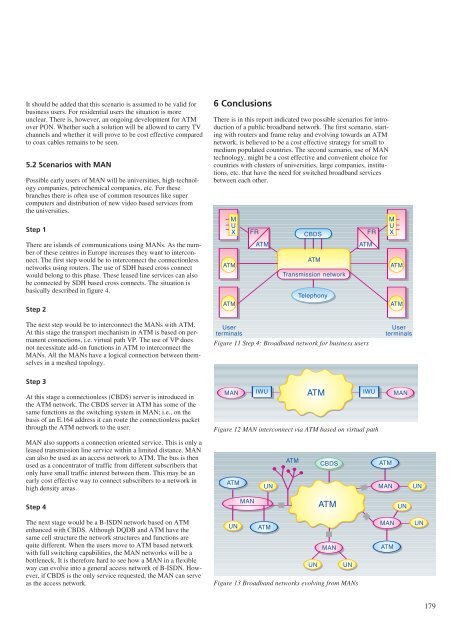Prognosemetoder – en oversikt - Telenor
Prognosemetoder – en oversikt - Telenor
Prognosemetoder – en oversikt - Telenor
You also want an ePaper? Increase the reach of your titles
YUMPU automatically turns print PDFs into web optimized ePapers that Google loves.
It should be added that this sc<strong>en</strong>ario is assumed to be valid for<br />
business users. For resid<strong>en</strong>tial users the situation is more<br />
unclear. There is, however, an ongoing developm<strong>en</strong>t for ATM<br />
over PON. Whether such a solution will be allowed to carry TV<br />
channels and whether it will prove to be cost effective compared<br />
to coax cables remains to be se<strong>en</strong>.<br />
5.2 Sc<strong>en</strong>arios with MAN<br />
Possible early users of MAN will be universities, high-technology<br />
companies, petrochemical companies, etc. For these<br />
branches there is oft<strong>en</strong> use of common resources like super<br />
computers and distribution of new video based services from<br />
the universities.<br />
Step 1<br />
There are islands of communications using MANs. As the number<br />
of these c<strong>en</strong>tres in Europe increases they want to interconnect.<br />
The first step would be to interconnect the connectionless<br />
networks using routers. The use of SDH based cross connect<br />
would belong to this phase. These leased line services can also<br />
be connected by SDH based cross connects. The situation is<br />
basically described in figure 4.<br />
Step 2<br />
The next step would be to interconnect the MANs with ATM.<br />
At this stage the transport mechanism in ATM is based on perman<strong>en</strong>t<br />
connections, i.e. virtual path VP. The use of VP does<br />
not necessitate add-on functions in ATM to interconnect the<br />
MANs. All the MANs have a logical connection betwe<strong>en</strong> themselves<br />
in a meshed topology.<br />
Step 3<br />
At this stage a connectionless (CBDS) server is introduced in<br />
the ATM network. The CBDS server in ATM has some of the<br />
same functions as the switching system in MAN; i.e., on the<br />
basis of an E.164 address it can route the connectionless packet<br />
through the ATM network to the user.<br />
MAN also supports a connection ori<strong>en</strong>ted service. This is only a<br />
leased transmission line service within a limited distance. MAN<br />
can also be used as an access network to ATM. The bus is th<strong>en</strong><br />
used as a conc<strong>en</strong>trator of traffic from differ<strong>en</strong>t subscribers that<br />
only have small traffic interest betwe<strong>en</strong> them. This may be an<br />
early cost effective way to connect subscribers to a network in<br />
high d<strong>en</strong>sity areas.<br />
Step 4<br />
The next stage would be a B-ISDN network based on ATM<br />
<strong>en</strong>hanced with CBDS. Although DQDB and ATM have the<br />
same cell structure the network structures and functions are<br />
quite differ<strong>en</strong>t. Wh<strong>en</strong> the users move to ATM based network<br />
with full switching capabilities, the MAN networks will be a<br />
bottl<strong>en</strong>eck. It is therefore hard to see how a MAN in a flexible<br />
way can evolve into a g<strong>en</strong>eral access network of B-ISDN. However,<br />
if CBDS is the only service requested, the MAN can serve<br />
as the access network.<br />
6 Conclusions<br />
There is in this report indicated two possible sc<strong>en</strong>arios for introduction<br />
of a public broadband network. The first sc<strong>en</strong>ario, starting<br />
with routers and frame relay and evolving towards an ATM<br />
network, is believed to be a cost effective strategy for small to<br />
medium populated countries. The second sc<strong>en</strong>ario, use of MAN<br />
technology, might be a cost effective and conv<strong>en</strong>i<strong>en</strong>t choice for<br />
countries with clusters of universities, large companies, institutions,<br />
etc. that have the need for switched broadband services<br />
betwe<strong>en</strong> each other.<br />
M<br />
U<br />
X<br />
ATM<br />
ATM<br />
User<br />
terminals<br />
Figure 11 Step 4: Broadband network for business users<br />
MAN<br />
Figure 12 MAN interconnect via ATM based on virtual path<br />
ATM<br />
UN<br />
MAN<br />
FR<br />
ATM<br />
IWU<br />
UN<br />
ATM<br />
CBDS<br />
ATM<br />
Transmission network<br />
ATM<br />
Telephony<br />
ATM<br />
UN<br />
CBDS<br />
ATM<br />
MAN<br />
UN<br />
Figure 13 Broadband networks evolving from MANs<br />
FR<br />
ATM<br />
IWU<br />
M<br />
U<br />
X<br />
ATM<br />
ATM<br />
User<br />
terminals<br />
ATM<br />
MAN<br />
MAN<br />
ATM<br />
MAN<br />
UN<br />
UN<br />
UN<br />
179
















